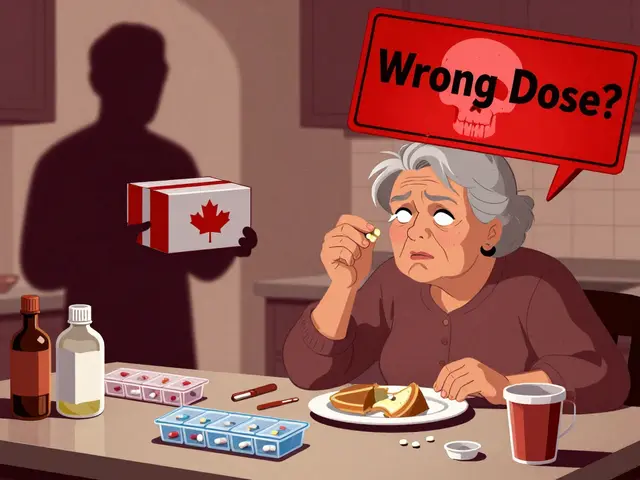Northern Prickly Ash might not be the first thing that comes to mind when you think of dietary supplements, but this underappreciated gem has a lot going for it. It’s been around for centuries, valued for its medicinal properties long before it became a trendy wellness supplement. But what exactly makes it worth considering?
Let's start with the basics: Northern Prickly Ash is a plant from the citrus family. It's often used in traditional medicine for its potential to ease discomfort and improve overall vitality. You might've heard it referred to as the 'toothache tree' due to its numbing effects, which already hints at its powerful properties.
Today, people are turning to Northern Prickly Ash more and more, drawn to its natural health benefits. It's not just a relic of old-time remedies; modern science has begun to back up some of these traditional claims, giving this ancient plant a new lease of life in the realm of health supplements. So if you're on the hunt for something that offers more than just basic vitamins, you might find Northern Prickly Ash deserves a spot in your regimen.
- Understanding Northern Prickly Ash
- Historical Uses and Benefits
- Modern-Day Applications
- Incorporating into Your Routine
- Potential Side Effects
- Tips for Buying Quality Supplements
Understanding Northern Prickly Ash
Let's dig into what exactly Northern Prickly Ash is and why it's worthy of attention. This plant is native to North America and falls under the citrus family. Its bark and berries are primarily what people use for medicinal purposes. Known scientifically as Zanthoxylum americanum, it's commonly found in regions from Canada down to the midwestern United States.
This shrub isn't just random. Native tribes and early settlers valued it for its wide range of health benefits. Historically, they used it to treat ailments like rheumatism, indigestion, and circulatory issues. And why was it called the 'toothache tree'? Well, chewing its bark was a quick way to numb and relieve tooth pain. That's pretty neat for something growing in the backyard, right?
Key Components
The Northern Prickly Ash contains several active compounds. Alkaloids and coumarins are a couple of the main components believed to contribute to its analgesic and anti-inflammatory properties. These compounds might not make it sound like dinner table talk, but they play a big role.
How It Works
So what makes this shrub tick? It's thought to activate certain pathways in the body that help manage pain and inflammation. Some folks use it today to stimulate the circulatory system and improve digestion. Plus, some studies suggest it has potential antimicrobial and antioxidant effects, adding more reasons it's grabbing attention in wellness circles.
Natural Habitat
You might find Northern Prickly Ash thriving in thickets and along riverbanks. It's quite the survivor, handling everything from dry, open woods to bustling roadsides. Its adaptability is partly why it was so accessible and widely used by those noticing its health perks.
- Appearance: Small to medium shrub with thorny branches and bright red berries.
- Bark: Brownish-gray and finely textured; its chewable nature is what lends to its nickname.
- Leaves: Compound and aromatic when crushed, much like the scent of a citrus plant.
Understanding its basic traits and historical uses gives you a sense of why this non-flashy plant's got a long-standing spot in natural medicine cabinets. And now, with modern-day science stepping in, it's definitely a contender for knocking on the door of your supplement shelf.
Historical Uses and Benefits
Diving into the past, Northern Prickly Ash holds a revered spot in the annals of traditional medicine. Native Americans were believed to be among the first to harness its potential, using bark and berries to alleviate toothaches, which earned it the nickname 'toothache tree.' Its numbing effect brought much-needed relief in a time before dental advancements.
Beyond dental issues, it was often employed to stimulate blood flow and counteract fatigue and sluggishness. Early healers and herbalists valued it for its wide range of applications, particularly in treating digestive problems and joint pain. Its anti-inflammatory properties even made it a favorite for soothing sore muscles after physical exertion.
Uses in Traditional European Medicine
European settlers adopted many of these practices after learning from indigenous people. Soon, the plant became popular across the Atlantic as well. One noted herbalist of the time described its influence by drawing attention to its versatility: "Northern Prickly Ash finds its purpose in a multitude of ailments, from circulatory to infectious, a true ally in the healer’s armory," observed 19th-century botanist John Uri Lloyd.
Benefits That Persist
What’s fascinating is that some of these historical uses have found their way into modern treatments. There are records of it being used to assist in managing rheumatoid arthritis due to its anti-inflammatory qualities, much like it was centuries ago. Its warming nature, thought to invigorate the system, remains a reason it's structured into some wellness regimes today.
As we explore the health landscape, it becomes clear how Northern Prickly Ash continues to be valued for its potent effects—a testament not just to its historical roots, but its enduring relevance.
Modern-Day Applications
With the rise in popularity of natural remedies, Northern Prickly Ash is making a name for itself. Its versatile uses in modern health regimens are gaining attention, mainly due to research supporting some of its traditional claims. So what are the actual ways people are using this in today's world?
Boosting Circulation and Energy
One key area where Northern Prickly Ash shines is its ability to potentially improve circulation. Many believe it stimulates blood flow, which can be a game-changer if you’re often feeling sluggish or tired. Enhanced circulation can lead to increased vitality and a sense of overall wellness.
Supporting Digestive Health
Got a sensitive stomach? This supplement might lend you a hand. It’s often used to manage digestive discomfort, helping to soothe the gastrointestinal tract. It’s all about bringing balance, so if your stomach has a mind of its own, this could be worth a try.
Enhancing Immune Function
Want to bolster your defense system? Northern Prickly Ash is sometimes included in immune-boosting blends. Some research suggests it might assist in keeping pesky colds and other infections at bay, making it a useful addition during those sniffly seasons.
Potential Anti-inflammatory and Analgesic Effects
You might call this the natural alternative to pain relief. Thanks to its potential anti-inflammatory properties, it’s used by some as a natural remedy for arthritis and joint pain. While not a substitute for over-the-counter meds, it could be a helpful complement for those looking to explore a more natural path.
How Do People Take It?
You can find Northern Prickly Ash in various forms, including capsules, powders, and even teas. Capsules are the most common, providing an easy way to incorporate it into your daily routine without complicating things.
Here’s a quick look at how people dose it:
- For general wellness: Typically 250-500 mg daily
- For digestive support: A similar range, tailored to your specific needs
- Capsules are often preferred for convenience
Remember, it’s always smart to consult a healthcare professional before diving into any new supplement, especially if you’re on medication or managing health conditions. Making informed decisions is key!

Incorporating into Your Routine
Getting started with Northern Prickly Ash is simpler than you might think. Whether you're a supplement newbie or a seasoned pro, adding it to your daily regimen can be a breeze. Here's how you can do it effectively.
Start Small, Go Steady
When introducing a new supplement like Northern Prickly Ash, it's a good idea to start with a lower dose. This will allow your body to adjust without any surprises. Many supplements of this type suggest beginning with around 500 mg per day. Consider it a starting point before you gradually increase the amount.
Forms and Formats
Northern Prickly Ash is available in several forms, making it flexible for any routine. You can find it as capsules, tinctures, or even teas. Capsules are convenient for those on-the-go, whereas a tincture lets you customize the dosage a bit more. If you're a tea lover, steeping the bark in hot water could be a relaxing addition to your wellness ritual.
Timing is Everything
The best time to take Northern Prickly Ash depends on your routine. Many prefer taking it with meals to improve absorption and aid digestion. However, listen to your body. Some people find taking it before bed helps them relax, while others notice a boost in energy when taken in the morning.
Complementing Other Supplements
If you're already on a supplement routine, you probably know that some ingredients work better together. Northern Prickly Ash can be paired with other wellness boosters like vitamin C or magnesium, potentially enhancing each other’s effects. Do check with a healthcare professional to ensure this fits well with your existing regimen.
Tracking Your Progress
Like with any supplement, it's important to pay attention to how your body responds. Consider keeping a simple journal, noting any changes in energy, digestion, or overall wellness. These notes can be handy when discussing your health goals during a checkup.
| Supplement Form | Common Dosage | Usage |
|---|---|---|
| Capsules | 500 mg/day | Convenient for daily intake |
| Tincture | About 30 drops | Flexible for personalized dosage |
| Tea | 1-2 cups/day | Relaxing and aromatic |
By making Northern Prickly Ash a consistent part of your daily habits, you tap into its natural benefits. Finding the right balance might take a little time, but the potential wellness perks are well worth it.
Potential Side Effects
Before diving into the benefits of Northern Prickly Ash, it’s important to chat about the possible side effects this supplement can cause. Even though it's all natural, your body might react to it differently than expected. Here's what you need to know.
Common Reactions
Most folks tolerate it pretty well, but like with any supplement, some people might experience mild issues. This might include an upset stomach or a bit of diarrhea if your system isn’t used to it. To ease into it, start with a small dose and see how your body responds.
Interactions with Medications
If you’re on other medications, especially for blood pressure or anticoagulants, you’ll want to check with your doc before adding Northern Prickly Ash to your diet. There’s a chance it could interact, which could either dilute or heighten the effects of your meds. Better be safe than sorry, right?
Allergic Reactions
Though rare, some might have an allergic reaction. If you notice any signs like a rash, itching, or swelling, stop using it immediately and seek medical advice. It's better to keep safe and get checked out if you think there might be an allergy at play.
Pregnant or Nursing Moms
The jury's still out on whether Northern Prickly Ash is totally safe for pregnant or nursing women. So, it's best to err on the side of caution and avoid it. After all, it’s all about keeping both the mom and baby healthy and safe.
Who Should Avoid It?
- Those with known allergies to citrus plants.
- People with sensitive digestive systems prone to inflammation.
- Anyone on anticoagulation therapy without consulting their healthcare provider.
Always treat new supplements with a little caution, and listen to your body. It’s great to look out for your health, but make sure you’re not doing more harm than good. That way, you can enjoy the benefits of Northern Prickly Ash without any drama.
Tips for Buying Quality Supplements
Thinking of adding Northern Prickly Ash to your wellness lineup? Picking a good supplement isn't always straightforward, but you can make it easier if you know what to look for. Here are some handy tips to help you choose the right one.
Check the Ingredients
First things first, always check the label. Make sure it contains pure Northern Prickly Ash without a bunch of unwanted fillers. A quality supplement will list the exact amount of the herb included.
Look for Reputable Brands
It pays to go with brands that have a good track record. Look for companies known for transparency and third-party testing.
"Third-party testing ensures the products meet a high-quality standard," says Dr. Sarah Jenkins, a nutrition expert. "It's a sign the company is serious about the safety and efficacy of their supplements."
Read Reviews and Testimonials
Real-world user reviews can offer insight into how well a product works. See if others have noticed the benefits you’re hoping for.
Watch for Certifications
Supplements with certifications like USDA Organic or NSF Certified often indicate better quality. These stamps usually reflect rigorous testing and higher manufacturing standards.
Consider the Form
Northern Prickly Ash comes in various forms like powders, capsules, and tinctures. Choose what suits your lifestyle best. Capsules are convenient, while powders and tinctures can be mixed into drinks.
| Form | Convenience | Absorption |
|---|---|---|
| Capsules | High | Moderate |
| Powders | Medium | High |
| Tinctures | Low | High |
Remember, investing time in choosing the right supplement can pay off in your journey to better health. With careful selection, Northern Prickly Ash can become a valuable tool in enhancing your wellness routine.







Priyamvada Toshniwal
March 21, 2025 AT 08:26Northern Prickly Ash is one of those plants that feels like it was forgotten by modern medicine but never by grandma’s herb cabinet. I’ve been taking it for about six months now, mostly for circulation-my feet used to go numb in winter, and now? Barely a chill. Not magic, but definitely noticeable. Also, the tea smells like citrusy pine, which is oddly comforting during rainy days. No side effects, just quiet improvement. Highly recommend trying it if you’re into gentle, old-school remedies.
Also, side note: if you’re in India, you can find dried bark at some Ayurvedic shops under the name 'Kolakattha'. Same plant, different name. Fun fact!
Just don’t chew the raw bark unless you wanna numb your tongue for an hour. Been there, lol.
Denise Wood
March 22, 2025 AT 05:14Okay but can we talk about how this is basically nature’s ibuprofen with extra steps? 🤔 I’ve been using it for mild joint pain since last winter and honestly? Better than the OTC stuff because I don’t feel like a zombie afterward. Also, the fact that it’s been used for toothaches since before antibiotics? Wild. I even made a tincture from dried bark I ordered online-30 drops in water, twice a day. No more waking up with stiff knuckles. Just sayin’-nature’s got a backup plan for everything.
PS: Always check the extract concentration. Some brands just dump filler and call it ‘prickly ash extract.’ Look for 1:5 tincture or standardized to alkaloid content. #NoFakes
Andrew Butler
March 22, 2025 AT 09:36Let’s be real-this is just another ‘ancient remedy’ being repackaged by wellness influencers to sell $40 capsules. The alkaloids? Yeah, they exist. But the bioavailability? Probably negligible unless you’re chewing bark like a beaver. And the ‘circulation boost’? That’s just capsaicin-level vasodilation. You could get the same effect from a cold shower or a shot of espresso. Also, the fact that this is a citrus relative means it’s probably going to interfere with your statins if you’re on them. Don’t be a lab rat. Stick to proven meds.
Also, ‘toothache tree’? Cool nickname. Doesn’t make it medicine. Just a plant with local anesthetic properties. We’ve had lidocaine since 1943. Progress, people.
Varun Gupta
March 22, 2025 AT 12:15💀 This is a distraction. They’re not selling you a supplement-they’re selling you a gateway to glyphosate-laced GMO bark from Big Herbal. 🤫 You think they’re harvesting this from the wild? Nah. It’s grown in monocultures with pesticides, then shipped through 7 countries, irradiated, and labeled ‘organic.’ They’re using your trust in ‘natural’ to sell you snake oil wrapped in a Native American aesthetic. And don’t even get me started on the ‘third-party testing’-that’s just a logo they buy on Fiverr. 🚨
Meanwhile, the real cure for joint pain? Stop sitting on your butt all day. Go outside. Walk. Breathe. Stop buying stuff. 🌿🚫
Also, why does every ‘ancient remedy’ come with a ‘consult your doctor’ disclaimer? Because they know they’re walking the line. 😏
Amy Reynal
March 24, 2025 AT 02:43Oh honey, you think this is new? 😏 I’ve got a 1922 herbalist’s journal from my great-aunt that says ‘Prickly Ash for sluggish blood and weary bones’-and she lived in the Ozarks with no running water, no phone, and still outlived half her neighbors. So yeah, ‘modern science’ is finally catching up to what rural folks knew before Google existed. And no, I don’t care that you think ‘alkaloids’ sound like sci-fi jargon-you don’t get to dismiss centuries of folk wisdom because your PhD didn’t include ‘how to talk to your grandma.’
Also, I’ve been giving this to my elderly neighbors who hate swallowing pills. They steep the bark in chamomile tea, add a splash of honey, and call it ‘sunset tonic.’ They say it helps their knees and makes them feel less ‘trapped in their own skin.’ That’s not placebo, that’s dignity.
And for the record? The ‘citrus allergy’ warning? Yeah, that’s real. I had a friend break out in hives after eating a mandarin and then taking this. So don’t be a hero. Test it slow. And if you’re gonna be sarcastic, at least be informed. 💅
Erick Horn
March 24, 2025 AT 10:45So you’re telling me chewing bark is better than Tylenol?
Got it.
Next.